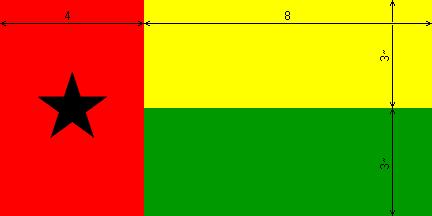 image by Željko Heimer, 23 October 2001
image by Željko Heimer, 23 October 2001
Last modified: 2016-03-25 by rob raeside
Keywords: star: 5 points (black on red) | pan-african | guinea bissau | guiné-bissau |
Links: FOTW homepage |
search |
disclaimer and copyright |
write us |
mirrors
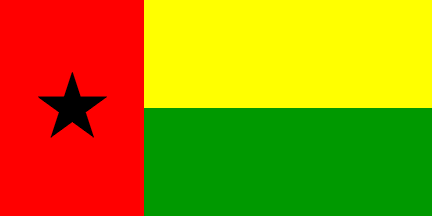 image by Željko Heimer, 23 October 2001
image by Željko Heimer, 23 October 2001
See also:
Yellow over green bicolour with red vertical stripe at hoist
containing a black five-pointed star.
Željko Heimer, 23 October 2001
The symbolism of this flag is inherited from the symbolism of
Ghana, from which it comes: an arrangement
of the pan-African colours with the
black star of Africa added.
Its proportions are, as in the party
flag, 1:2.
Jorge Candeias, 02 November 1999
I have a photo from the independence war where the flag with Cabral
image were already used. Issued in magazine Afrique-Asie.
Jaume Ollé, 30 April 2003
 image by Željko Heimer, 23 October 2001
image by Željko Heimer, 23 October 2001
The Album 2000 [pay00] says "![]() ≅1:2".
The construction details are given, but since the overall ratio is
approximate, the construction details are inevitably so. The two
horizontal stripes are of the same size, of course, and the width of
the vertical stripe is one third of the total length.
The star appears to be inscribed in a circle with the center in the
midpoint of the red stripe and of diameter equal to two units used on
the scheme (i.e. 1/3 of hoist).
≅1:2".
The construction details are given, but since the overall ratio is
approximate, the construction details are inevitably so. The two
horizontal stripes are of the same size, of course, and the width of
the vertical stripe is one third of the total length.
The star appears to be inscribed in a circle with the center in the
midpoint of the red stripe and of diameter equal to two units used on
the scheme (i.e. 1/3 of hoist).
Željko Heimer, 23 October 2001
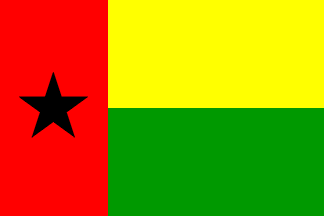
![]() image by Željko Heimer and António Martins, 26 July 2009
image by Željko Heimer and António Martins, 26 July 2009
This might be not really a mistaken depiction, as I read somewhere in the
1st constitution of Guinea Bissau (or maybe in the Statute of P.A.I.G.C.) that
the three areas of the flag are to have the same area, saying nothing about the
final ratio of the flag.
António Martins, 26 July 2009
In 1978, the East German Post issued a 20 Pf.
stamp marking the 5th death anniversary of Amílcar Cabral (1924-1973),
showing e.g. a 2:3 depiction of the flag, flat on the background.
António Martins, 26 July 2009
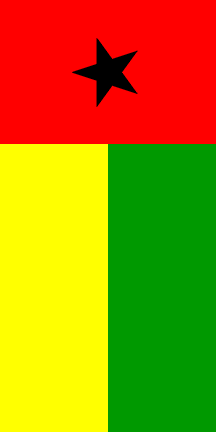 image
by Željko Heimer, 12 January 2004
image
by Željko Heimer, 12 January 2004
A photo on the book História da Guiné e Ilhas de Cabo
Verde, by PAIGC, 1974, shows the
assembly of Madina do Boé (place of the unilateral declaration of
independence, 24 Sep. 1973) in the bush or jungle with lots of small
flags and a large one
in vertical position in a rope like clothes to dry. The main flag, and
some small, are shown with the darker (the green) stripe to the right,
which means we see the reverse side of the flag (it’s not a
reversed image, because there are some bands with words that we can
read). The photo is captioned «Bruna Amico © Gamma, Paris».
With the examples of this book and Cabral’s poster, I wonder if
there is trend or old habit to use the Bissau-Guinea flag in vertical
position.
Francisco Santos, 29 and 30 April 2003
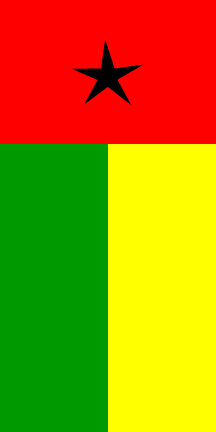 image
by Francisco Santos, 12 January 2004
image
by Francisco Santos, 12 January 2004
In the book História da Guiné e Ilhas de Cabo Verde, by
PAIGC, 1974, the only image on the cover is
a vertical Guinean-Bissau flag, with a “leaner” star.
The book does have only one image on the cover page, which is like the
national flag in vertical position, with the difference that it has an
irregular star, pointed to the top (of the image/book).
Francisco Santos, 29 and 30 April 2003
See also:
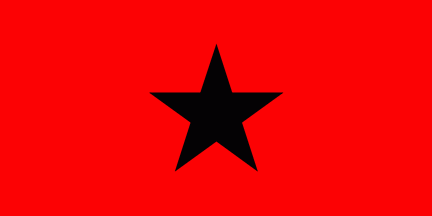 image by Horváth Zoltán, 16 January 2012
image by Horváth Zoltán, 16 January 2012
It seems that Armed Forces or Army of Guinea Bissau has an own flag. Based
on this
picture (here)
it is red with a large black star in the middle of the flag. Please
note that aircraft marking has a similar design.
Horváth Zoltán, 16 January 2012
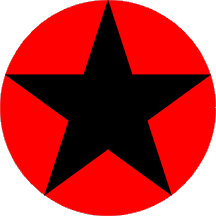 image by Željko Heimer, 23 October 2001
image by Željko Heimer, 23 October 2001
Força Aérea da Guiné-Bissau was formed in 1978 and
since it foundation use a black 5 points star on red disc as roundel.
Dov Gutterman, 16 June 2004
Red roundel with black five-pointed star. Album 2000
[pay00] show the star
“throughout”, while [cos98]
has it a bit smaller, probably both variations are to be seen.
Željko Heimer, 23 October 2001
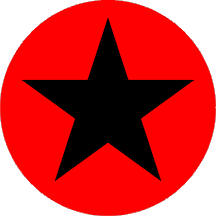 image by Željko Heimer, 23 October 2001
image by Željko Heimer, 23 October 2001
From
this
and this
photo, seems that it is something between…
Dov Gutterman, 16 June 2004
Guinea Bissau also have a Coast Guard, G. C. Marítima, whose
plane have a national flag as fin flash. See
this
photo.
Dov Gutterman, 16 June 2004